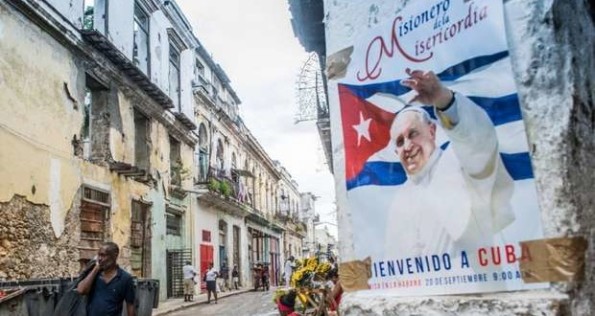
Ivan Garcia, 18 September 2015 — After enjoying a strong espresso, sixty-eight year old Samuel Quijano lights a hand-rolled cigarette and looks at the sky, hoping for a sign of rain.
Quijano is the owner of a small parcel of land, located one and a half kilometers from the National Highway, where he grows vegetables, beans and has a row of tired banana trees.
“The drought is killing the land. It seems like a curse from God. There isn’t enough rain to produce good crops. The animals get sick and die from hunger and thirst. We’ll see if Pope Francis performs a miracle and brings us rain,” says Samuel, who is tending an emaciated cow as she forages on a small hillside.
The farmer has been attending Mass for a couple of years, more out of boredom than curiosity or devotion. “You have to believe in something. If not, you’re empty as a person,” he notes.
His personal history is interwoven with the political operations led by Fidel Castro. “It’s two steps forward and two steps backwards, and no one understands what’s going on,” he says. “I was a soldier in Angola. Being a Catholic back then was like being a dissident now. I really don’t know what will come out of the Pope’s visit. I’ll settle for some rain.”
Seventy-two hours before the Supreme Pontiff lands in Havana, most people do not seem to be paying much attention. The go about their business, running around town in search of food and looking for ways to earn a few extra pesos to supplement their meager family incomes.
The military regime is getting ready to welcome the Argentine pope. On Tenth of October Street, a brigade of state workers is plastering the bare windows of state-run store with posters of Pope Francis in front of a Cuban flag.
Jorge Bergoglio will be received like a Missionary of Mercy. For the past two weeks there has been a steel platform lined with wood and surrounded by red, white and blue flags standing ready in the Plaza of the Revolution.
Flanking the impromptu sanctuary is the bust of Cuba’s “apostle,” Jose Marti, and to the left of the papal platform is an outsized hologram of the Argentine guerrilla Che Guevara.
Some of the capital’s thoroughfares through which the vicar of Rome will pass have been spruced up. Carlos III Avenue and Reina Street have been given a coat of cheap paint while Havana’s majestic cathedral has undergone a thorough restoration.
“Whenever a pope visits, the same thing happens. They fix up the outsides, but the insides of houses are still screwed up. The government only cares about appearances,” says a peanut vendor outside the old hardware store Feito y Cabezon on busy Reina Street.
As usually happens in state visits that the regime wants to highlight, employees at businesses, schools and official institutions in Havana have been summoned to Pope Francis’ first Mass on September 20.
Eugenio, an ETECSA employee, has his doubts. “On the one hand, there is the tremendous heat. When the Mass is over at eleven or twelve, the sun will be baking the pavement. Meanwhile, the Pope will go off to have a gourmet lunch while everyone else will go home to heat up leftovers from the night before. Maybe I’ll go, especially since my boss told us he would provide a snack, which I can later sell for forty pesos (around two dollars),” he says.
Trucks and bulldozers hurriedly collect tons of trash and garbage piled onto city streets. Workers from Public Health carry out fumigation raids on the Aedes aegypty mosquito, the carrier of dengue hemorrhagic fever, a disease which has almost become a national pandemic.
Although Pope Francis enjoys wide popularity in Cuba, there are segments of the population which are still waiting for recognition from the Holy Father.
A large mid-twentieth century house in the La Vibora neighborhood serves as headquarters for a Yoruba association.
Ernesto Sanabria, a babaloa — an indigenous priest — with twenty-seven years experience and a member of this organization, is fanning himself with an old magazine. He ponders why, given the fact that the followers of Afro-Cuban religions like himself outnumber Cuba’s Catholics by three to one, “none of the last three popes had shown any interest in meeting with the diverse religious denominations on the island. It’s unacceptable.”
The local dissident community also feels like it is not being heard. Berta Soler, leader of the Ladies in White, has asked to meet with the Pope. So far, she has received no reply.
The perception among dissidents is that Francis, like John Paul II and Benedict XVI, will not meet with them in order to avoid angering the regime.
Loose phrases by Pope Francisco that speak of freedom and democracy make up the politically correct part of the mass. The other is liturgy and symbolism.
For his part, Raul Castro granted amnesty to 3,522 prisoners and it is likely he will return a handful of properties confiscated from the church in the early 1960s.
Everything else will remain the same. The church will not be given a role in eduction or public health. Its periodicals will still have only a limited circulation and its social projects will still be marginalized.
Meanwhile, farmers like Samuel Quijano believe the Supreme Pontiff can, through his blessing, bring the rain the crops need. On the other side of the ring, dissidents like Berta Soler are asking the Catholic church to join in the calls for democracy and freedom for some fifty political prisoners.
But the Vatican does not do miracles. The pope is only God’s messenger on earth. We will have to keep praying.
